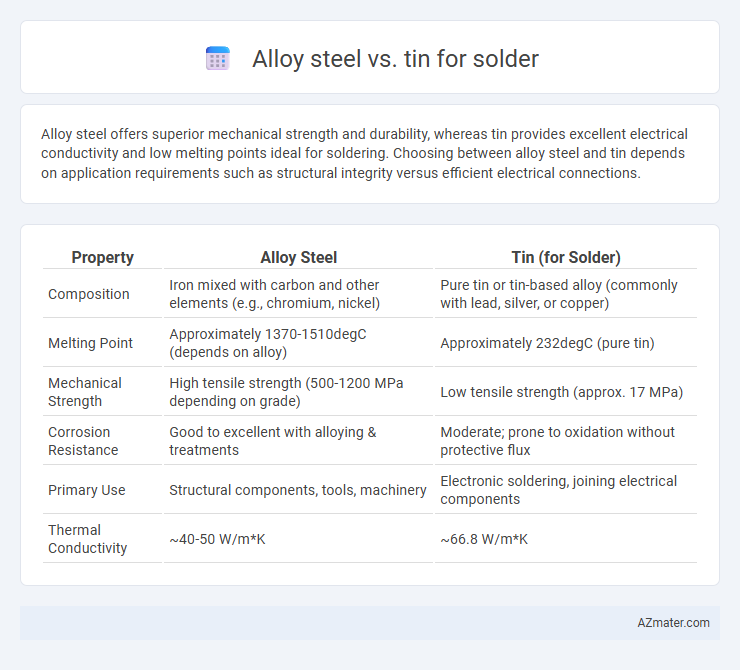Alloy steel offers superior mechanical strength and durability, whereas tin provides excellent electrical conductivity and low melting points ideal for soldering. Choosing between alloy steel and tin depends on application requirements such as structural integrity versus efficient electrical connections.
Table of Comparison
| Property | Alloy Steel | Tin (for Solder) |
|---|---|---|
| Composition | Iron mixed with carbon and other elements (e.g., chromium, nickel) | Pure tin or tin-based alloy (commonly with lead, silver, or copper) |
| Melting Point | Approximately 1370-1510degC (depends on alloy) | Approximately 232degC (pure tin) |
| Mechanical Strength | High tensile strength (500-1200 MPa depending on grade) | Low tensile strength (approx. 17 MPa) |
| Corrosion Resistance | Good to excellent with alloying & treatments | Moderate; prone to oxidation without protective flux |
| Primary Use | Structural components, tools, machinery | Electronic soldering, joining electrical components |
| Thermal Conductivity | ~40-50 W/m*K | ~66.8 W/m*K |
Introduction to Alloy Steel and Tin in Soldering
Alloy steel, known for its strength and durability, is rarely used as a solder material but can serve as a robust substrate in soldering applications, providing mechanical support and heat resistance. Tin, a primary component in most solder alloys, offers excellent wetting properties and low melting points, making it ideal for creating reliable electrical and mechanical bonds. The combination of these materials in soldering processes ensures strong, conductive joints essential for electronics manufacturing and repair.
Composition and Properties of Alloy Steel
Alloy steel, composed primarily of iron mixed with elements such as chromium, nickel, and molybdenum, exhibits high tensile strength, corrosion resistance, and hardness, making it unsuitable for soldering applications requiring low melting points. Tin, a soft, malleable metal with a low melting point of 232 degC, is ideal for solder due to its excellent wetting properties and ability to form strong, conductive joints. The alloy steel's durability and structural integrity contrast with tin's superior conductivity and melting characteristics crucial for effective soldering.
Characteristics and Uses of Tin in Solder
Tin in solder offers excellent corrosion resistance, low melting point around 232degC, and superior wettability, making it ideal for creating reliable, conductive joints in electronics. Its softness and ductility accommodate thermal and mechanical stresses, ensuring strong bonding with various metals. Tin-based solders are widely used in electrical wiring, circuit boards, and plumbing due to their efficient melting behavior and minimal oxidation during soldering.
Melting Points: Alloy Steel vs Tin
Alloy steel typically has a melting point ranging from 1370degC to 1510degC, while tin used for solder melts at a much lower temperature of approximately 232degC. The significant difference in melting points makes tin ideal for soldering applications where low-temperature melting is essential to avoid damaging electronic components. In contrast, alloy steel's high melting point makes it unsuitable for solder but valuable for structural applications requiring heat resistance.
Electrical Conductivity Comparison
Alloy steel exhibits significantly lower electrical conductivity compared to tin, making it less suitable for solder applications where optimal electrical flow is critical. Tin offers high conductivity, around 9.17 x 10^6 S/m, ensuring efficient current transfer in electronic assemblies. The superior conductivity of tin alloys enhances solder joint reliability and performance in electrical circuits.
Strength and Durability for Solder Joints
Alloy steel offers superior strength and durability compared to tin when used for solder joints due to its enhanced mechanical properties and resistance to wear and fatigue. Tin, commonly used as a solder material, provides excellent electrical conductivity and corrosion resistance but lacks the structural robustness required for high-stress applications. Solder joints incorporating alloy steel components maintain integrity under thermal cycling and mechanical loads better than those relying solely on tin-based solders.
Corrosion Resistance: Alloy Steel vs Tin
Alloy steel exhibits significantly higher corrosion resistance compared to tin, making it a preferred choice in harsh environments where durability is essential. Tin, while offering good solderability and a protective oxidation layer, is more prone to corrosion, especially in acidic or saline conditions. The formation of stable passivation layers in alloy steel contributes to its superior longevity and reliability in corrosive applications.
Common Applications in Electronics and Industry
Alloy steel is rarely used for soldering in electronics due to its high melting point and limited electrical conductivity, whereas tin-based solders are prevalent because of their low melting point and excellent conductivity. Tin solder, often combined with lead or silver, is the industry standard for creating reliable electrical connections on circuit boards and electronic components. In industrial applications, tin solder provides superior wetting properties and corrosion resistance, making it ideal for precision joining tasks where durability and efficiency are critical.
Cost and Availability of Materials
Alloy steel solder alternatives tend to be less common and often more expensive due to specialized metal blends and manufacturing processes, limiting widespread availability. Tin solder is widely used in electronics for its affordability and abundant supply, making it a cost-effective choice for large-scale applications. The readily accessible nature of tin reduces overall production costs, favoring its use over more costly alloy steel in soldering tasks.
Choosing the Right Material for Soldering Needs
Alloy steel and tin differ significantly in soldering applications, with tin alloys such as tin-lead or tin-silver-copper being preferred for their excellent electrical conductivity and low melting points, which ensure reliable, strong joints. Alloy steel is rarely used as a solder material due to its high melting temperature and poor wetting properties, making it unsuitable for delicate electronic components. Choosing tin-based solder alloys is ideal for precise and efficient soldering needs, particularly in electronics and fine metalwork.

Infographic: Alloy steel vs Tin for Solder
 azmater.com
azmater.com